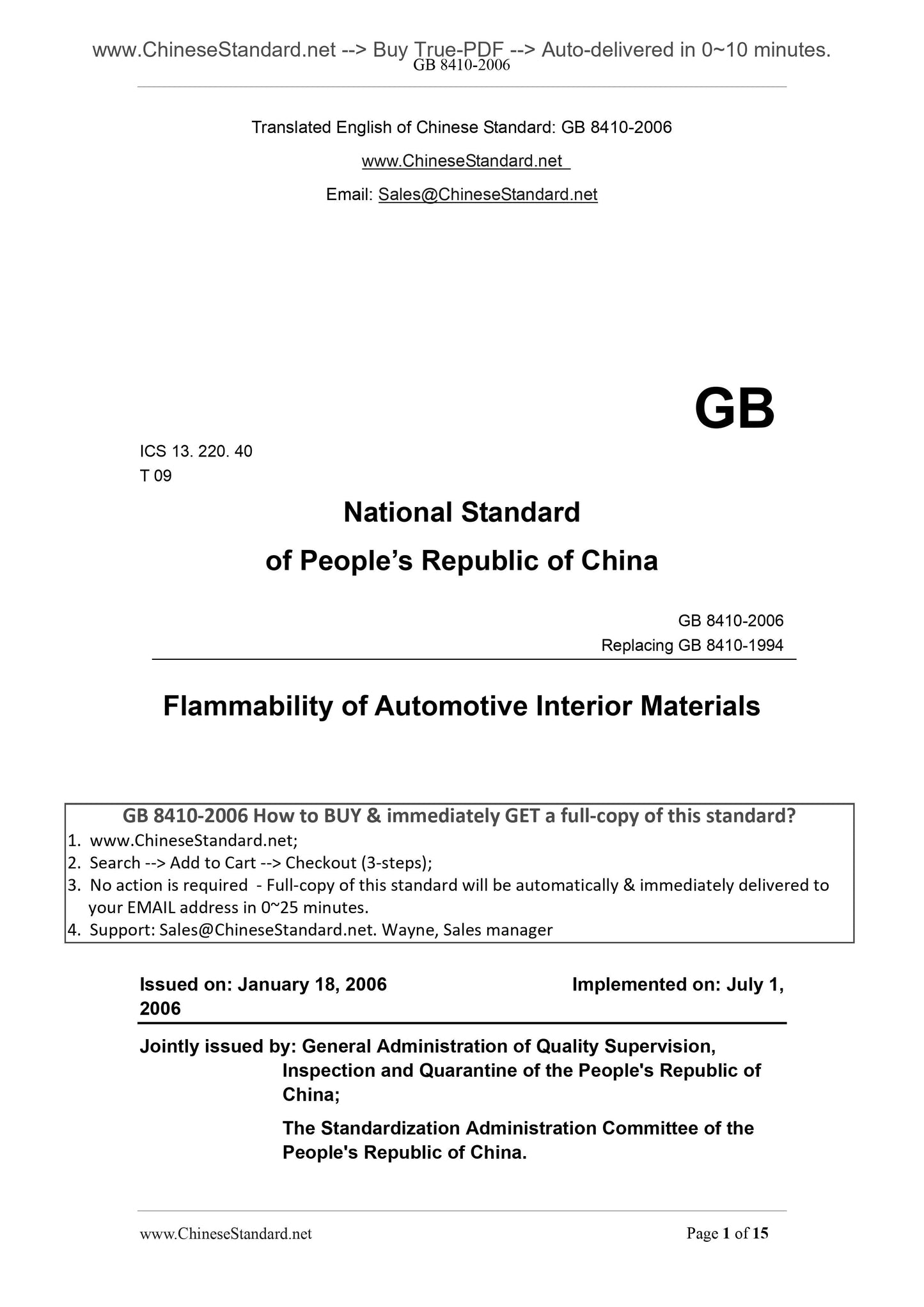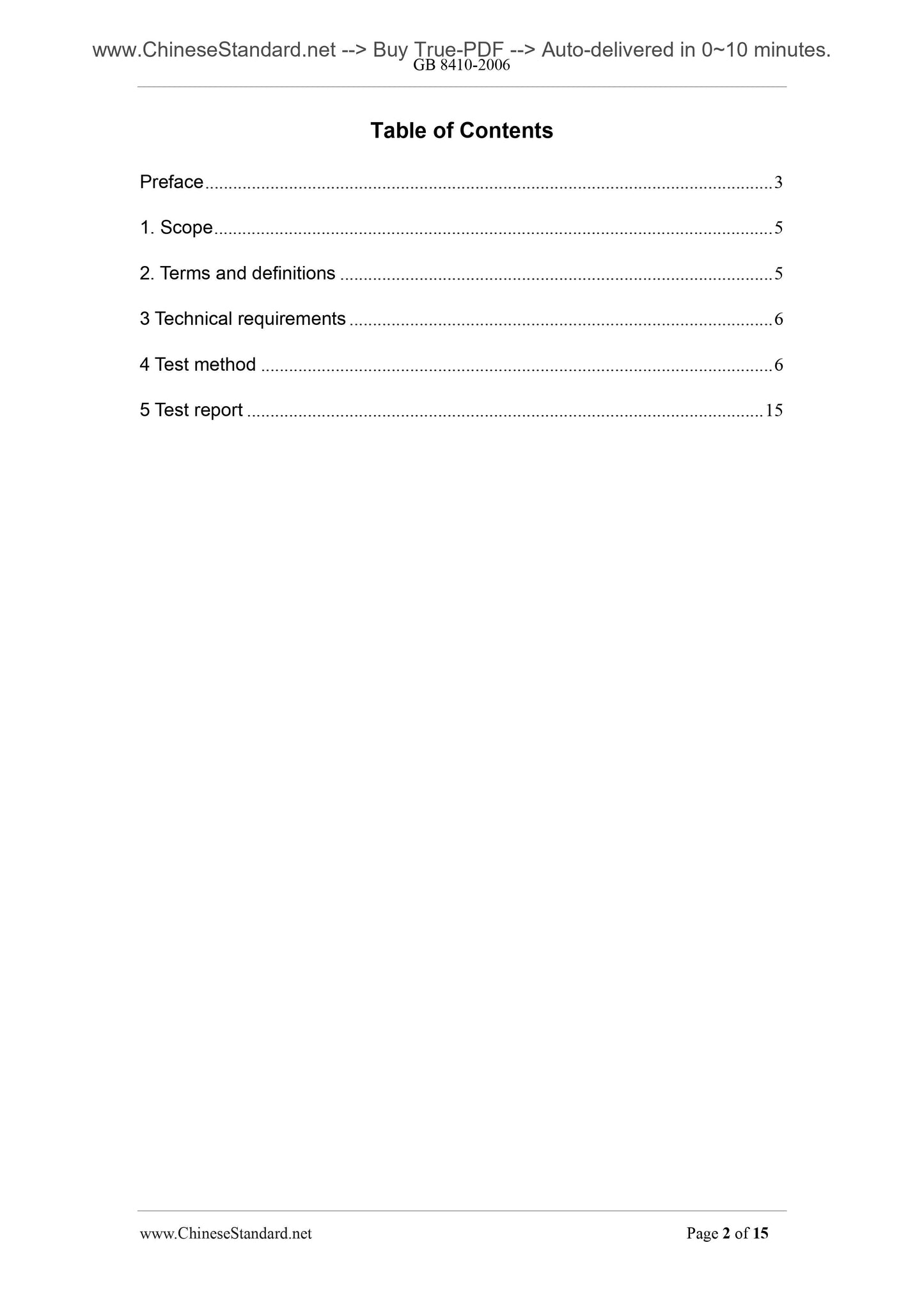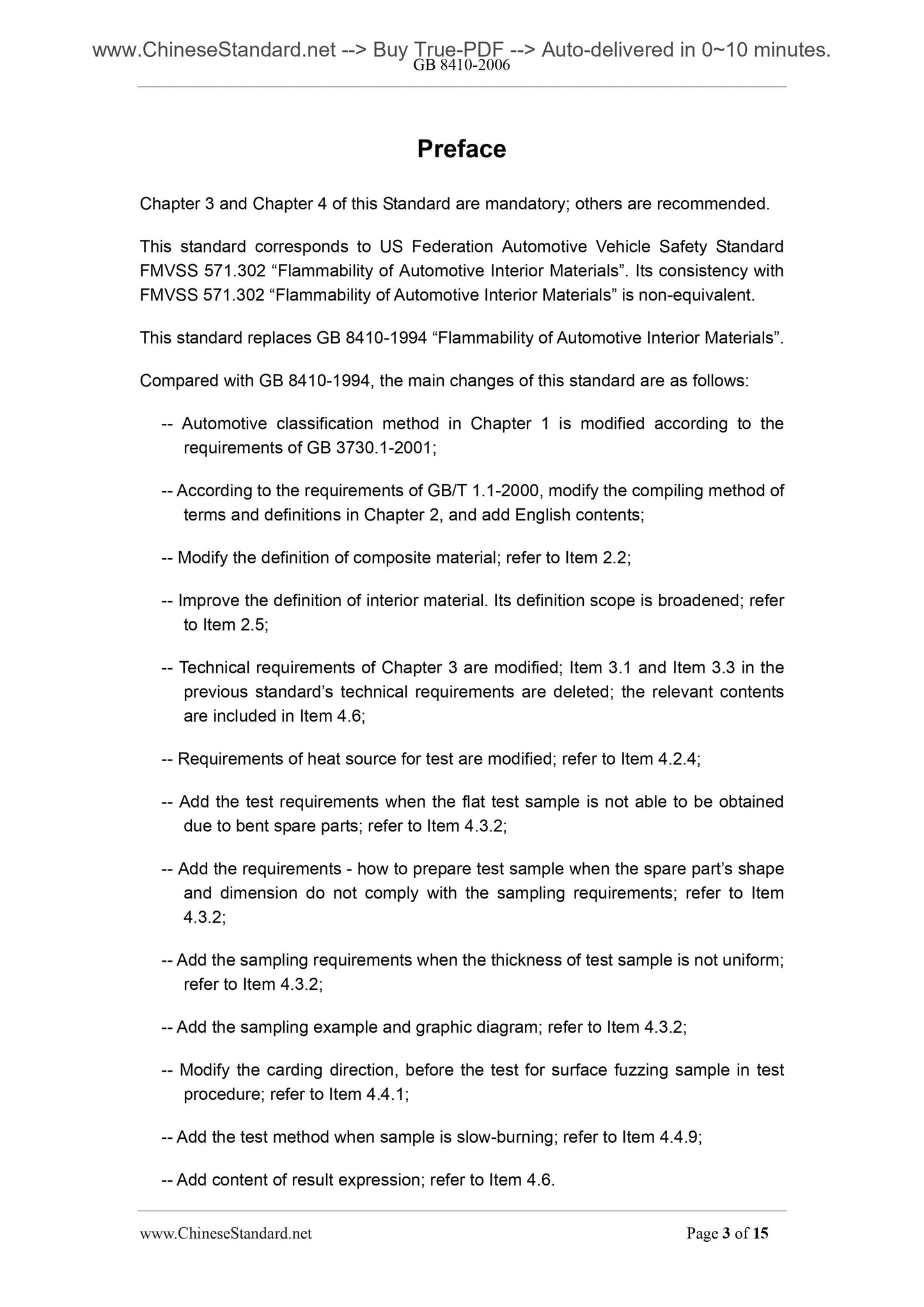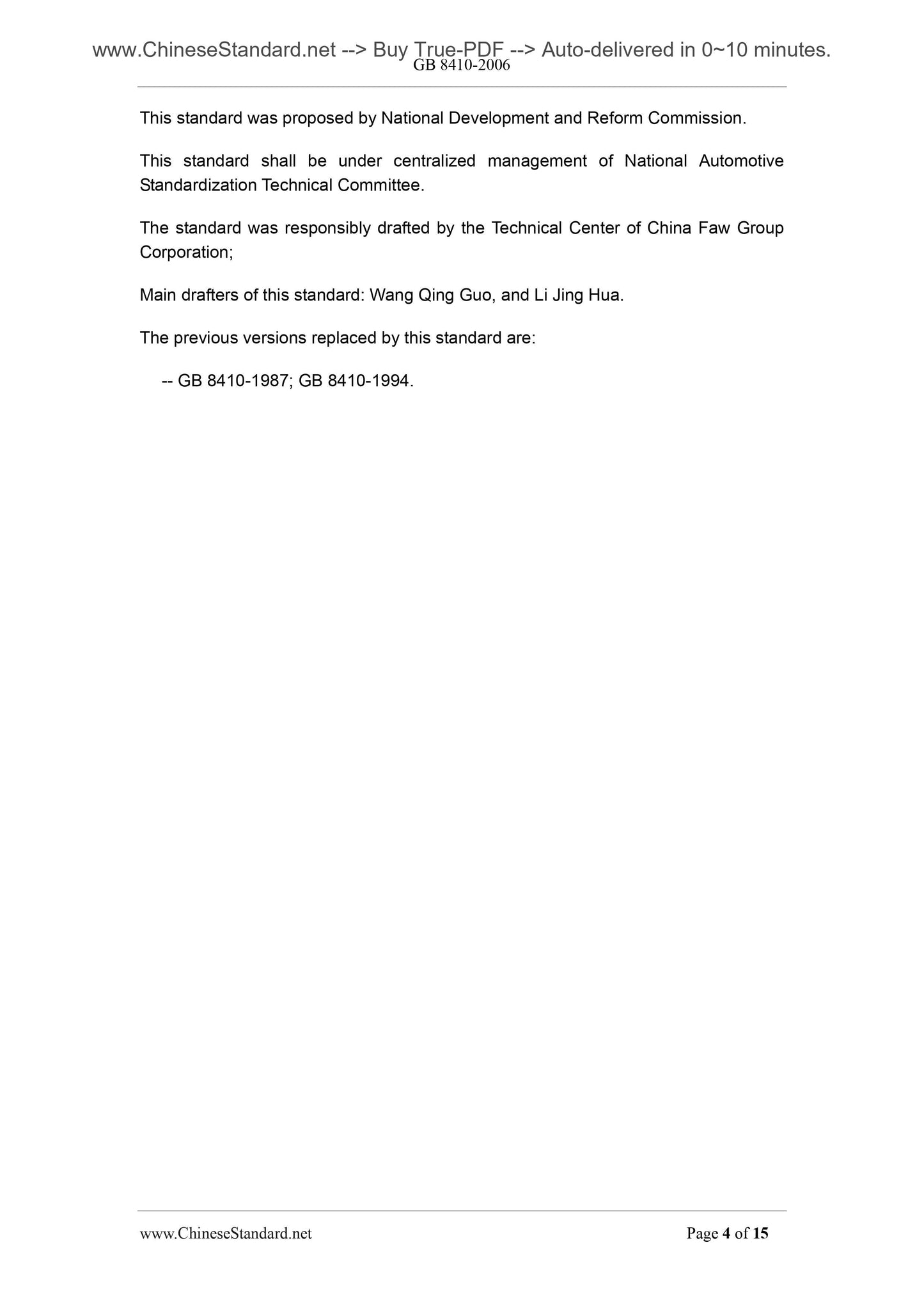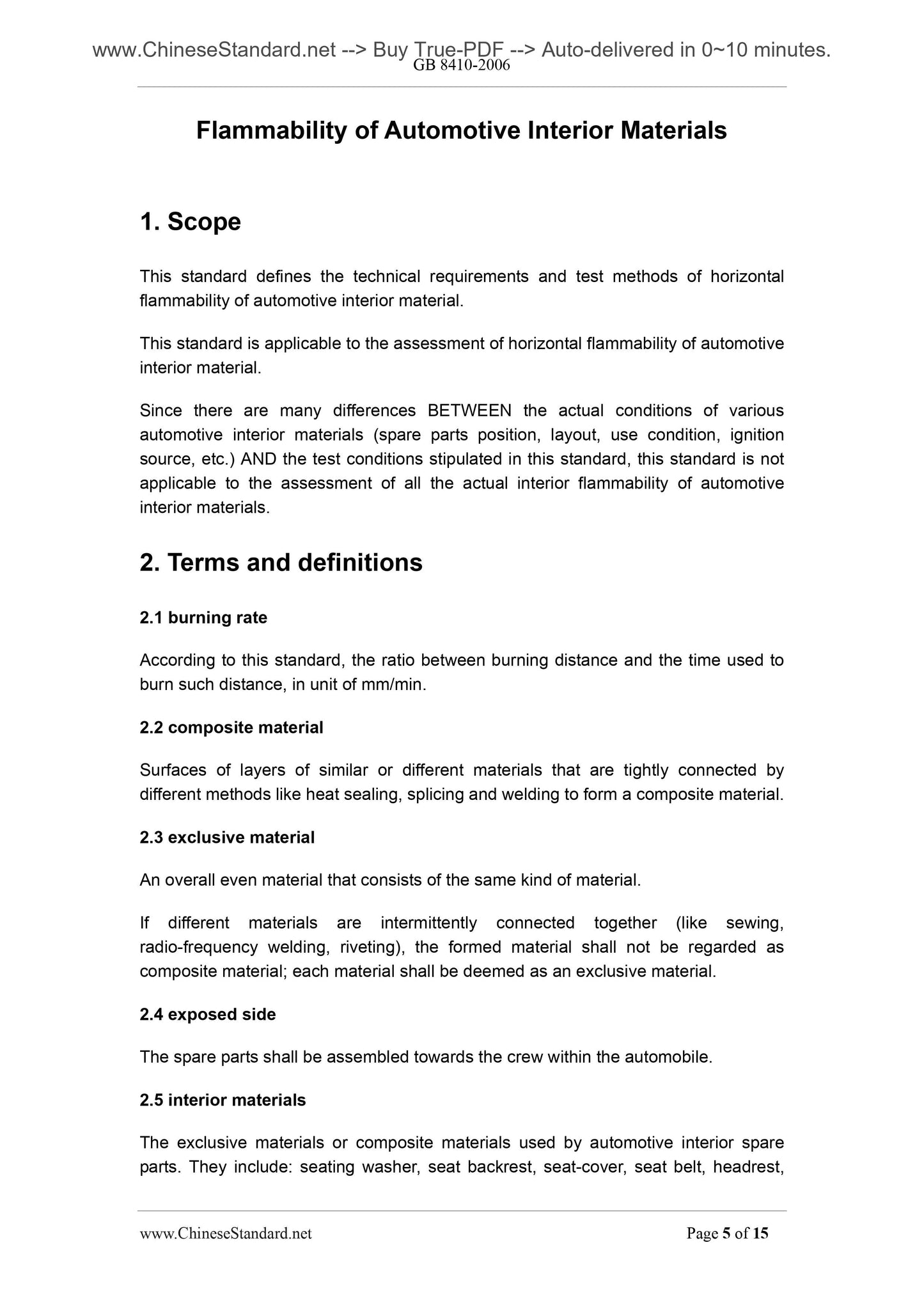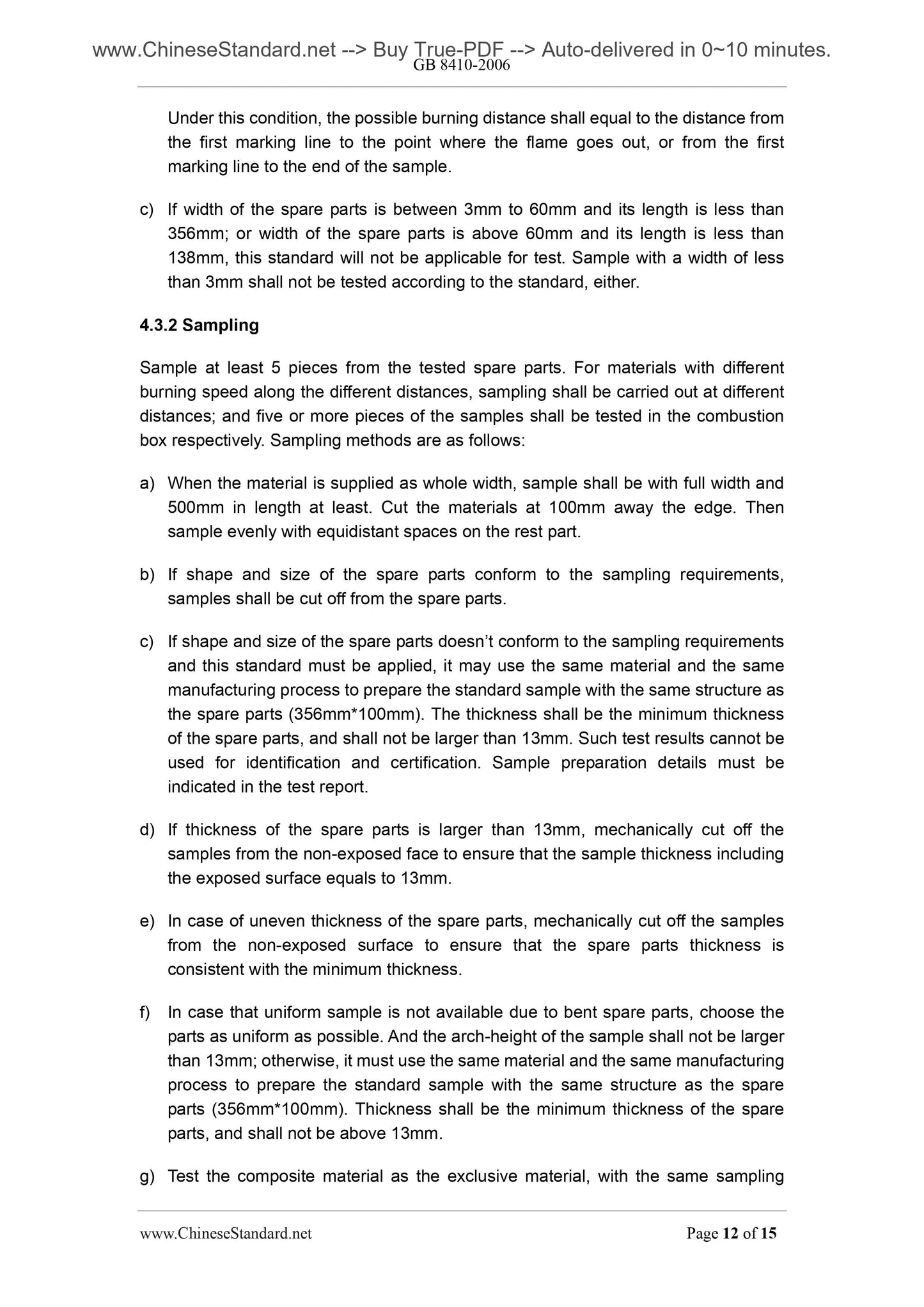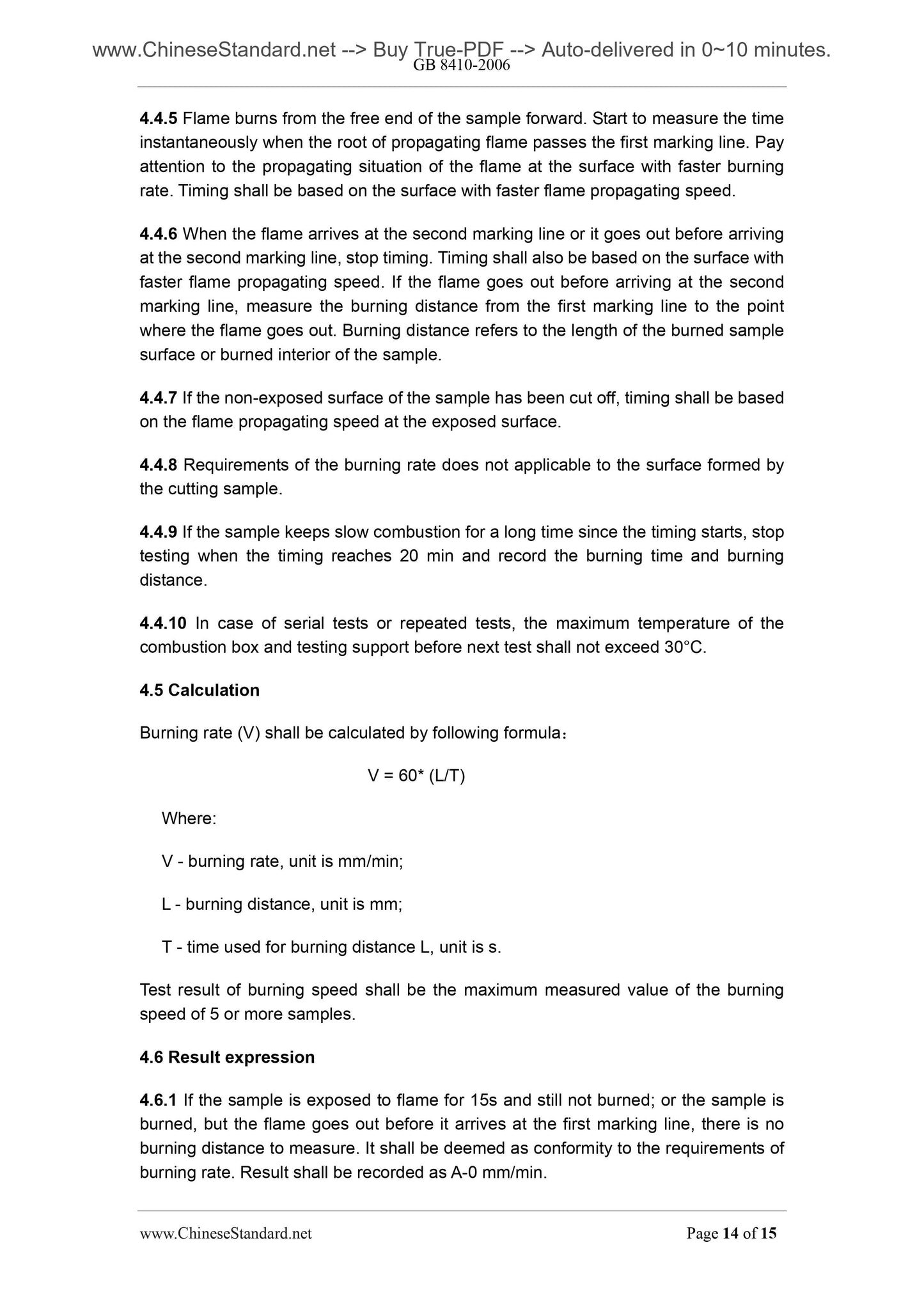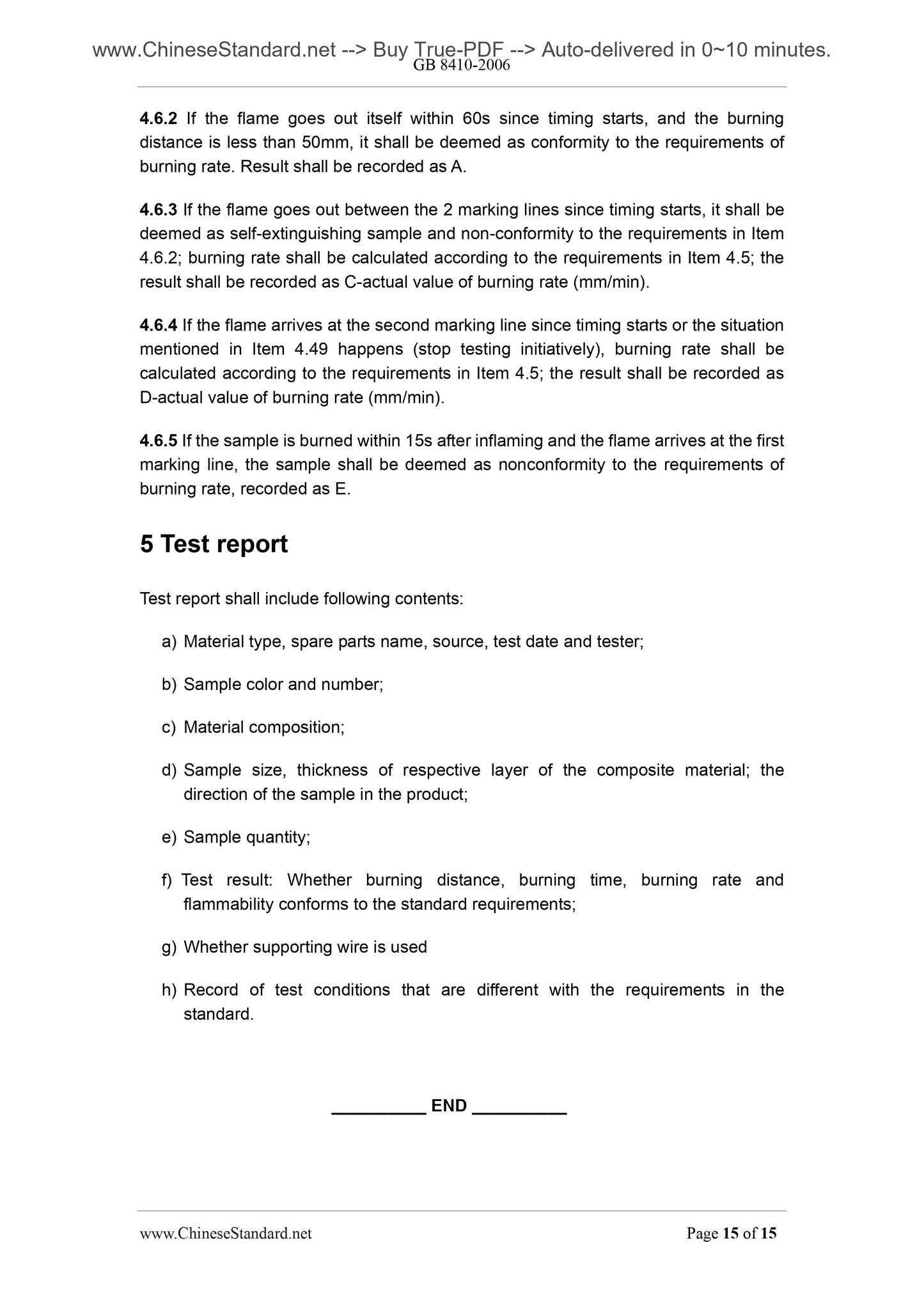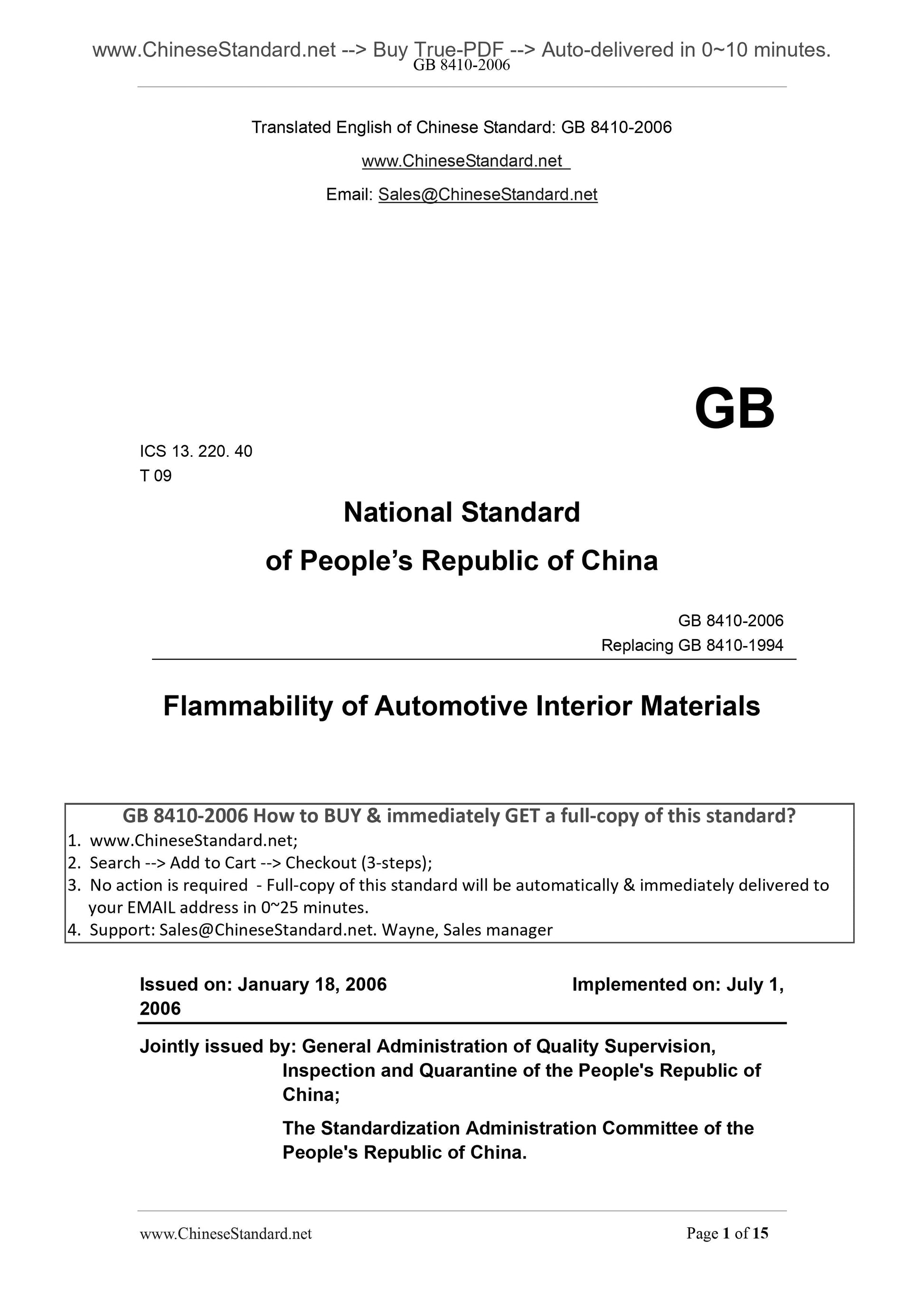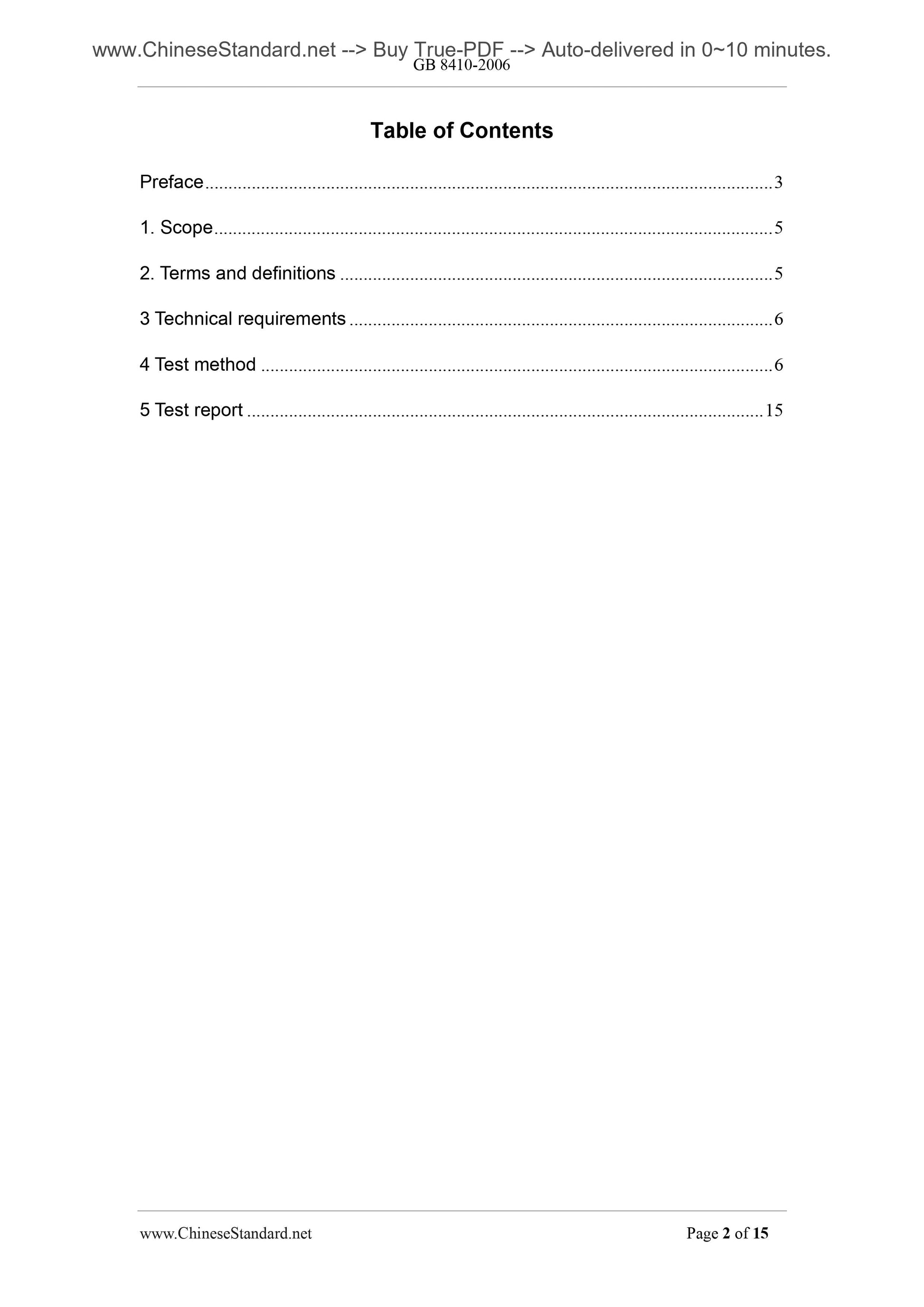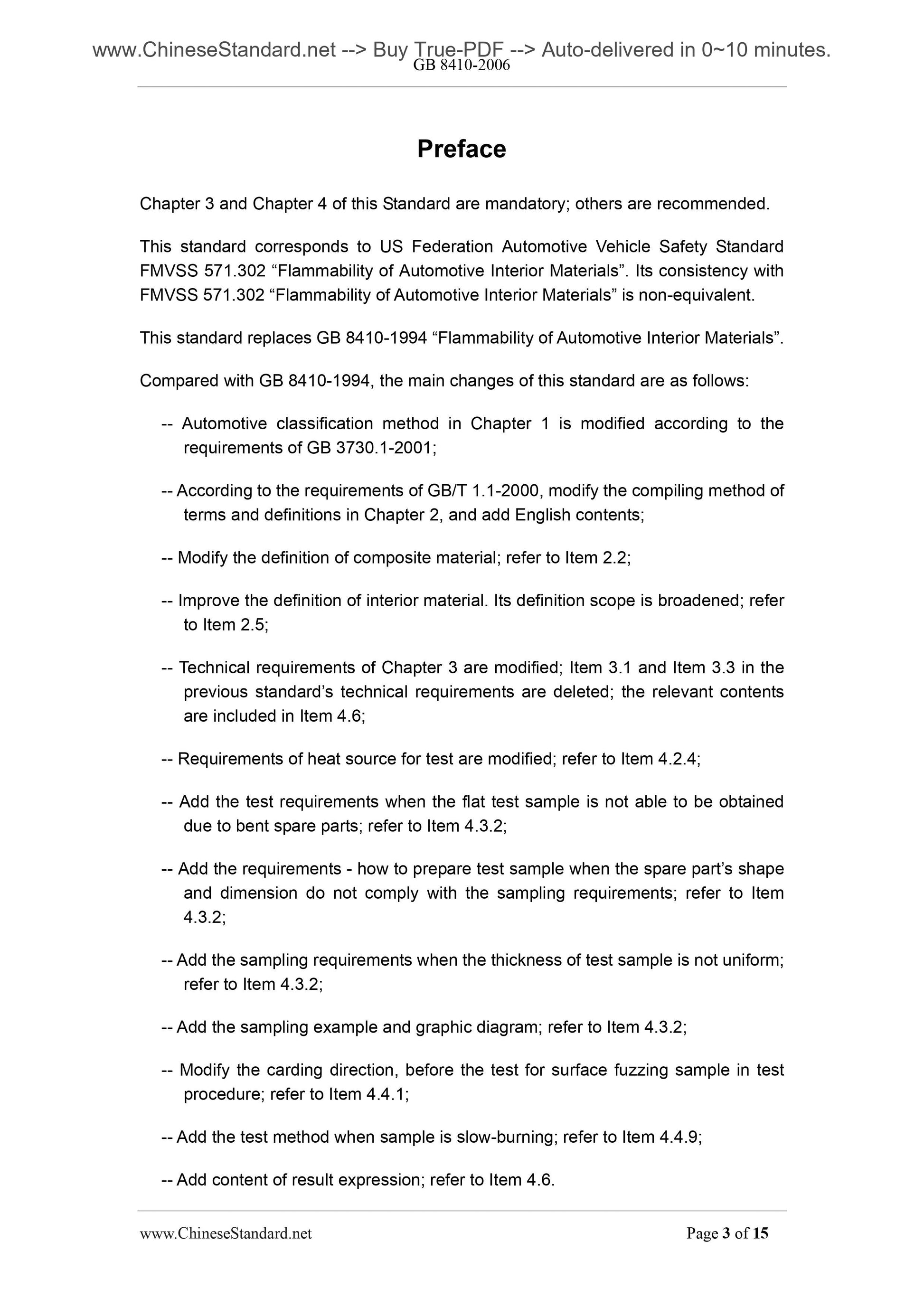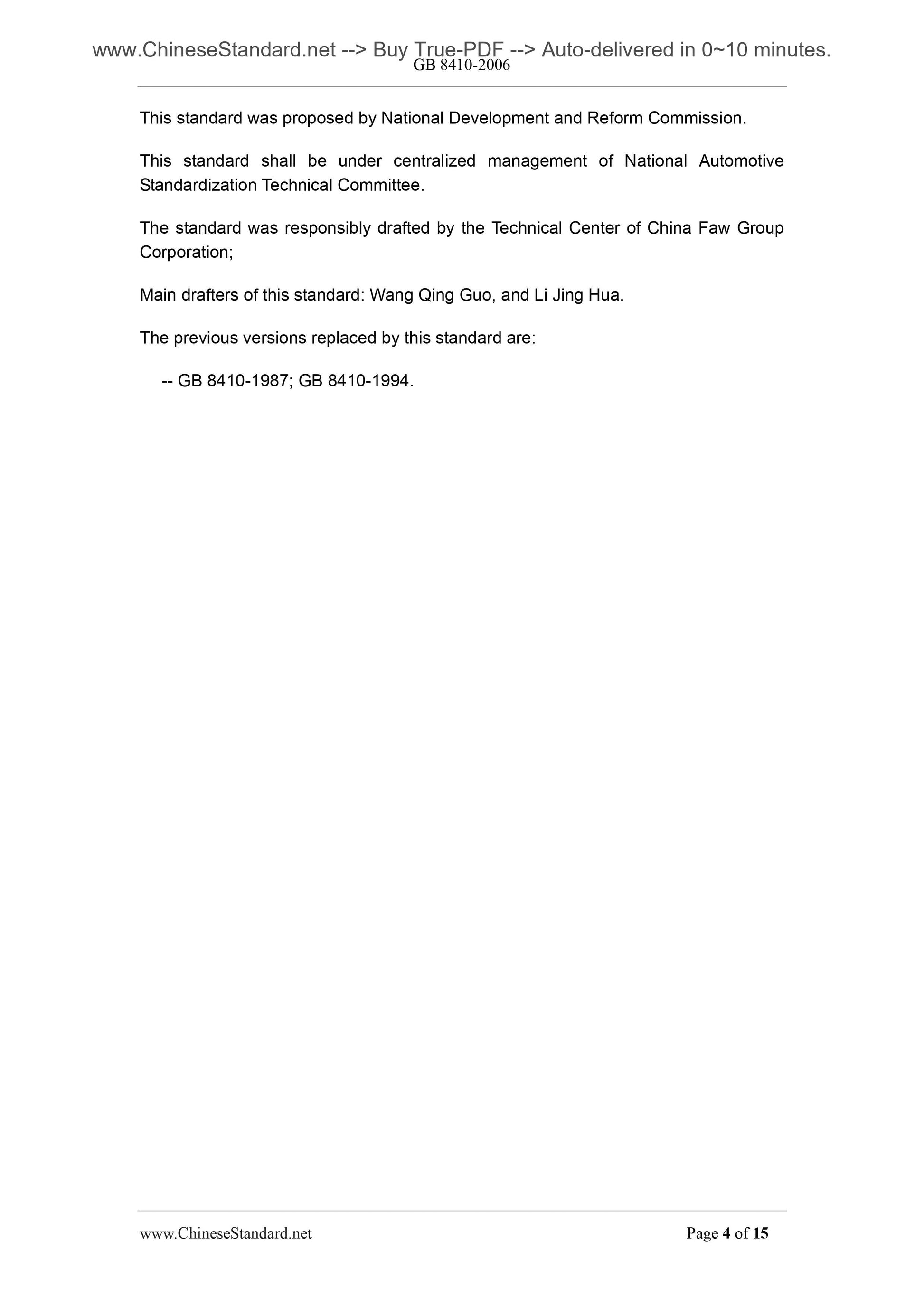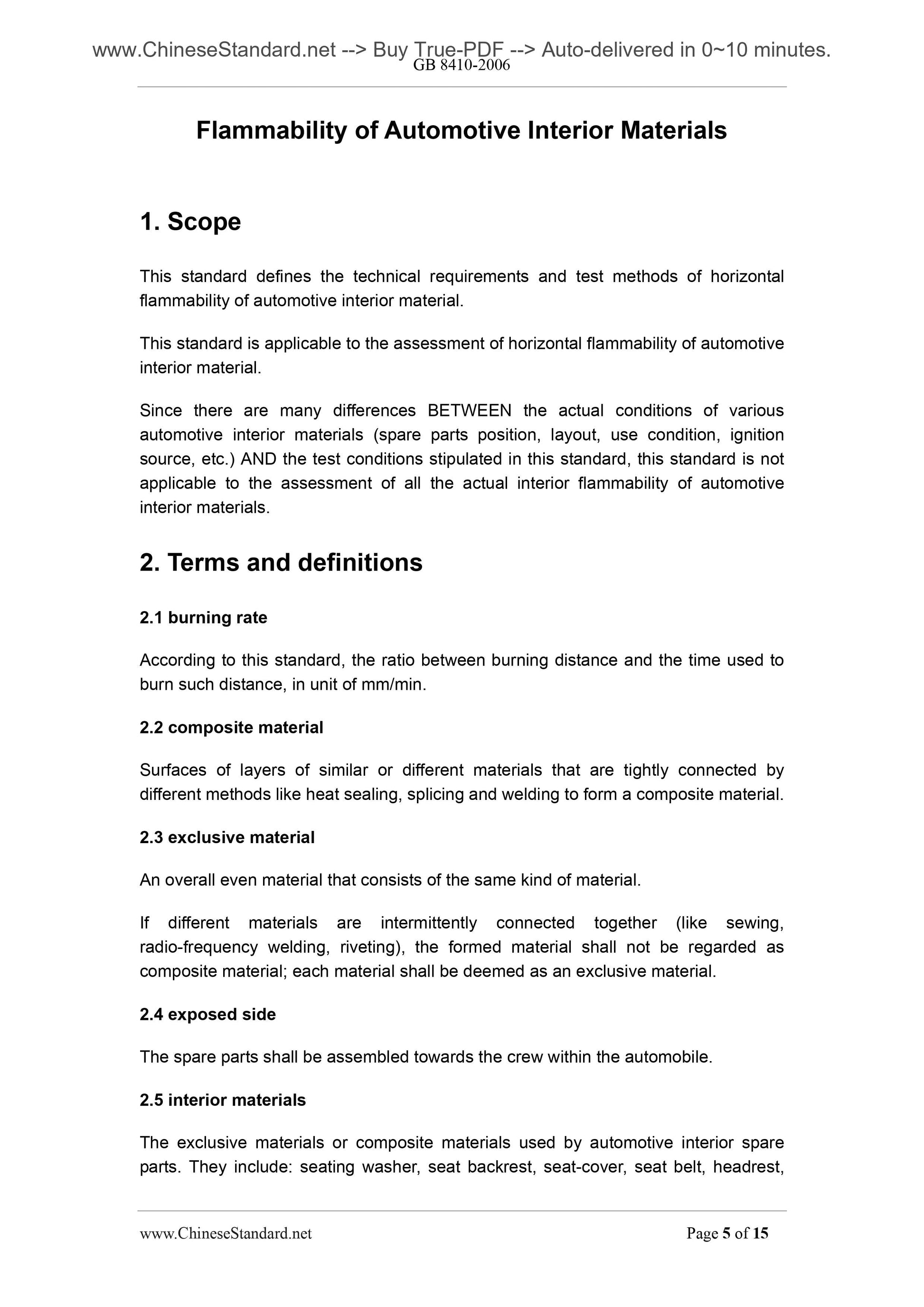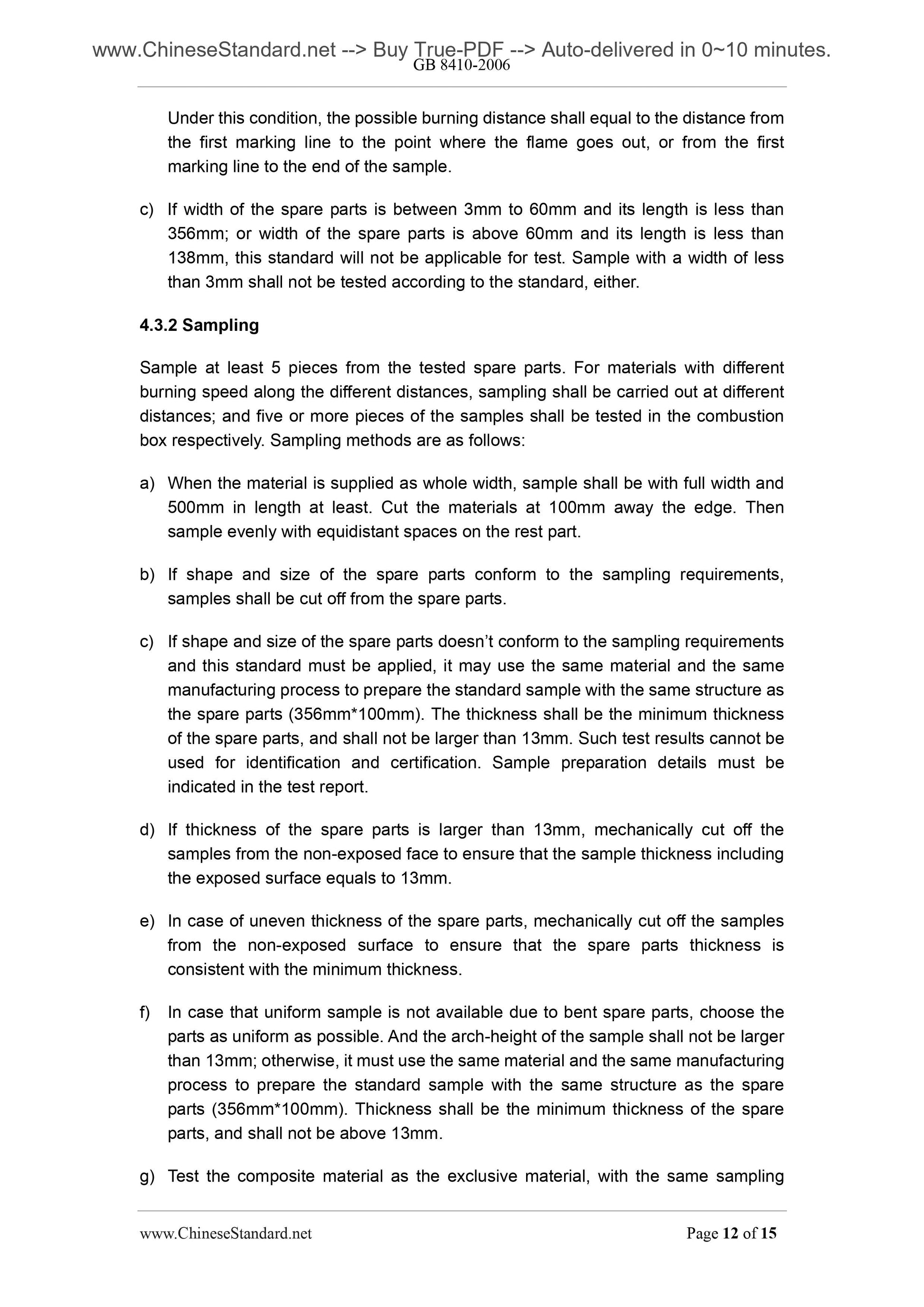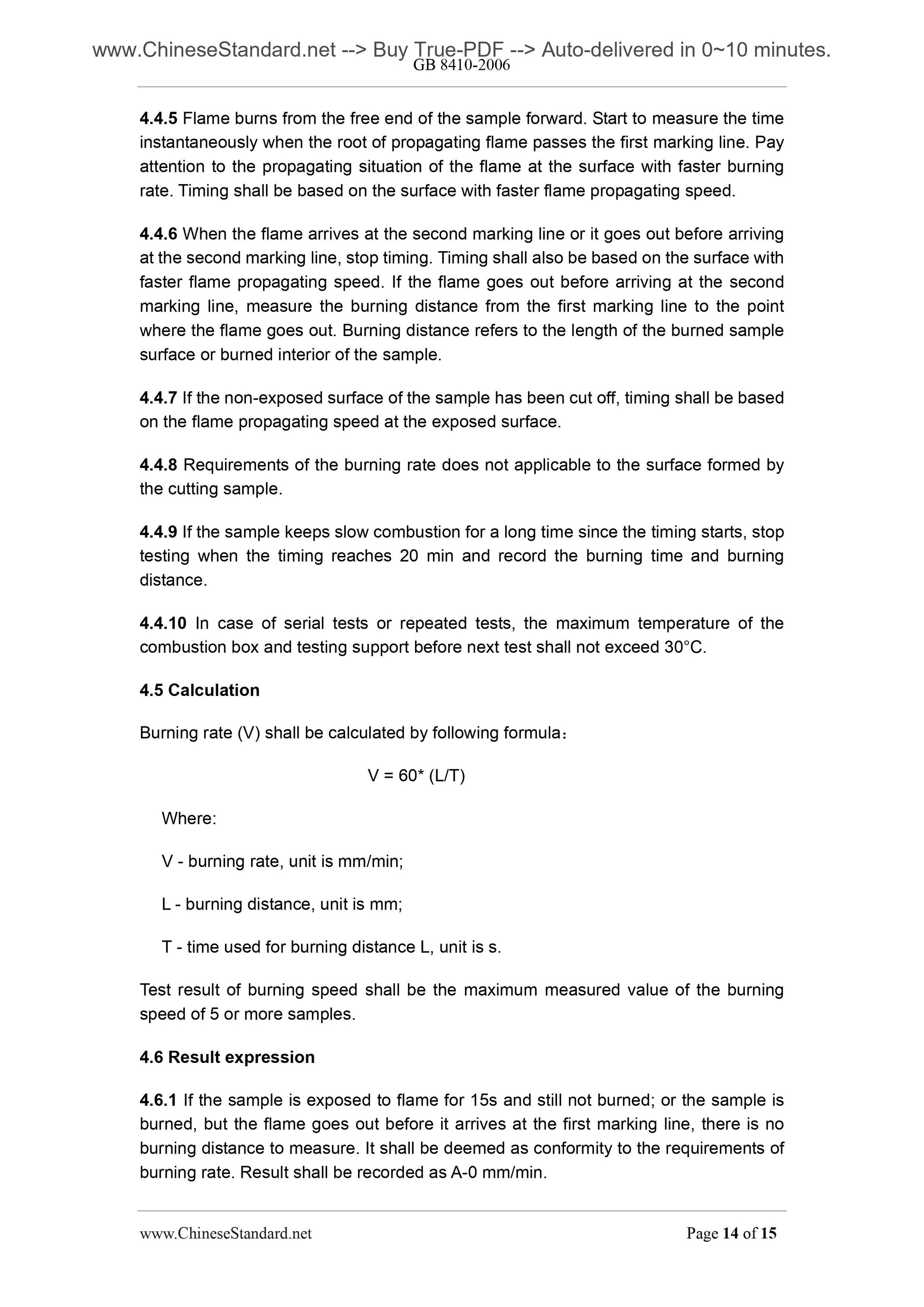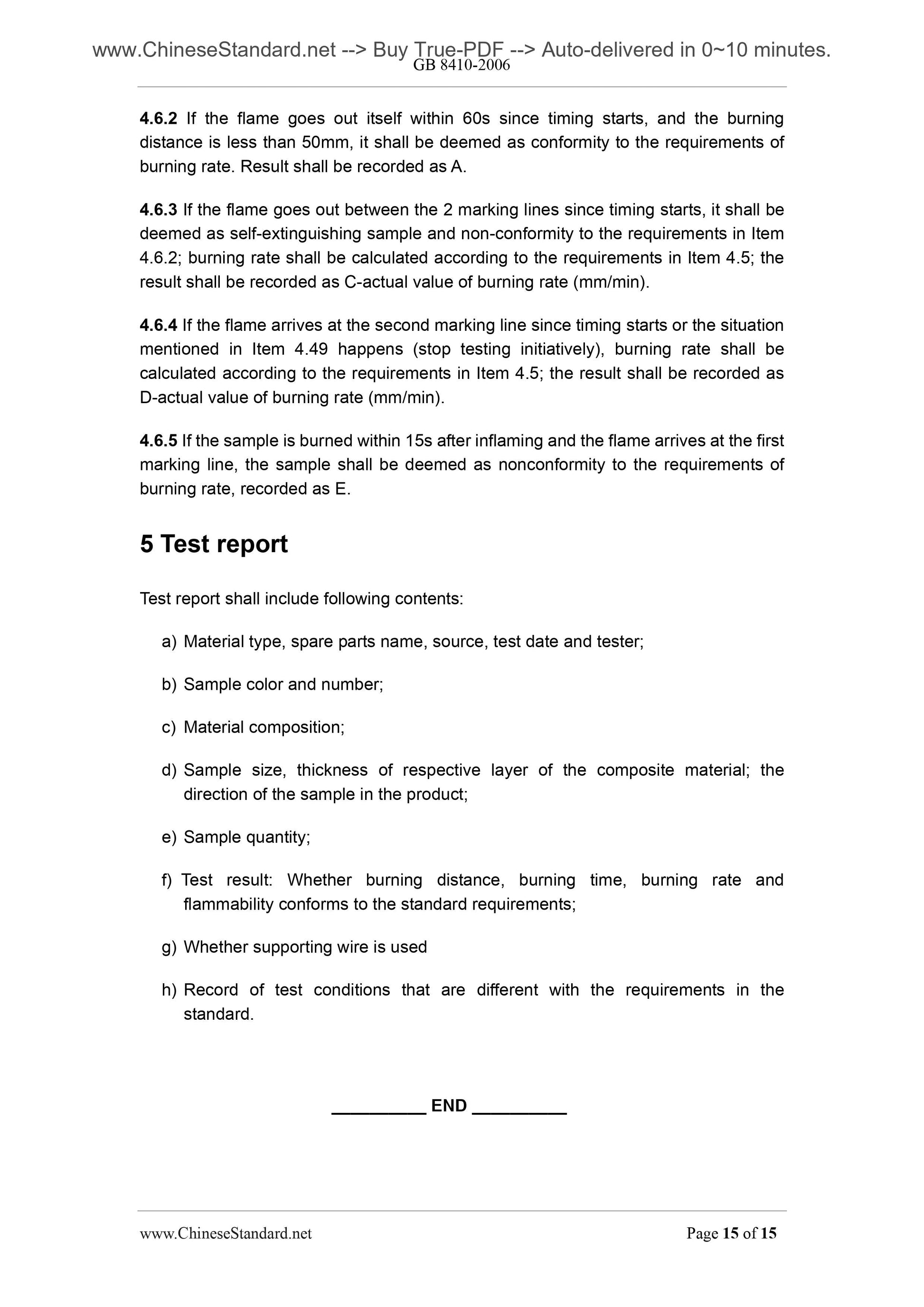1
/
of
8
PayPal, credit cards. Download editable-PDF & invoice in 1 second!
GB 8410-2006 English PDF (GB8410-2006)
GB 8410-2006 English PDF (GB8410-2006)
Regular price
$85.00 USD
Regular price
Sale price
$85.00 USD
Unit price
/
per
Shipping calculated at checkout.
Couldn't load pickup availability
Delivery: 3 seconds. Download true-PDF + Invoice.
Get QUOTATION in 1-minute: Click GB 8410-2006
Historical versions: GB 8410-2006
Preview True-PDF (Reload/Scroll if blank)
GB 8410-2006: Flammability of automotive interior materials
GB 8410-2006
GB
ICS 13. 220. 40
T 09
National Standard
of People’s Republic of China
Replacing GB 8410-1994
Flammability of Automotive Interior Materials
ISSUED ON. JANUARY 18, 2006
IMPLEMENTED ON. JULY 1,
Jointly issued by. General Administration of Quality Supervision,
Inspection and Quarantine of the People's Republic of
China;
The Standardization Administration Committee of the
People's Republic of China.
Table of Contents
Preface ... 3
1. Scope ... 5
2. Terms and definitions ... 5
3 Technical requirements ... 6
4 Test method ... 6
5 Test report ... 15
Preface
Chapter 3 and Chapter 4 of this Standard are mandatory; others are recommended.
This standard corresponds to US Federation Automotive Vehicle Safety Standard
FMVSS 571.302 “Flammability of Automotive Interior Materials”. Its consistency with
FMVSS 571.302 “Flammability of Automotive Interior Materials” is non-equivalent.
This standard replaces GB 8410-1994 “Flammability of Automotive Interior Materials”.
Compared with GB 8410-1994, the main changes of this standard are as follows.
-- Automotive classification method in Chapter 1 is modified according to the
requirements of GB 3730.1-2001;
-- According to the requirements of GB/T 1.1-2000, modify the compiling method of
terms and definitions in Chapter 2, and add English contents;
-- Modify the definition of composite material; refer to Item 2.2;
-- Improve the definition of interior material. Its definition scope is broadened; refer
to Item 2.5;
-- Technical requirements of Chapter 3 are modified; Item 3.1 and Item 3.3 in the
previous standard’s technical requirements are deleted; the relevant contents
are included in Item 4.6;
-- Requirements of heat source for test are modified; refer to Item 4.2.4;
-- Add the test requirements when the flat test sample is not able to be obtained
due to bent spare parts; refer to Item 4.3.2;
-- Add the requirements - how to prepare test sample when the spare part’s shape
and dimension do not comply with the sampling requirements; refer to Item
4.3.2;
-- Add the sampling requirements when the thickness of test sample is not uniform;
refer to Item 4.3.2;
-- Add the sampling example and graphic diagram; refer to Item 4.3.2;
-- Modify the carding direction, before the test for surface fuzzing sample in test
procedure; refer to Item 4.4.1;
-- Add the test method when sample is slow-burning; refer to Item 4.4.9;
-- Add content of result expression; refer to Item 4.6.
This standard was proposed by National Development and Reform Commission.
This standard shall be under centralized management of National Automotive
Standardization Technical Committee.
The standard was responsibly drafted by the Technical Center of China Faw Group
Corporation;
Main drafters of this standard. Wang Qing Guo, and Li Jing Hua.
The previous versions replaced by this standard are.
-- GB 8410-1987; GB 8410-1994.
Flammability of Automotive Interior Materials
1. Scope
This standard defines the technical requirements and test methods of horizontal
flammability of automotive interior material.
This standard is applicable to the assessment of horizontal flammability of automotive
interior material.
Since there are many differences BETWEEN the actual conditions of various
automotive interior materials (spare parts position, layout, use condition, ignition
source, etc.) AND the test conditions stipulated in this standard, this standard is not
applicable to the assessment of all the actual interior flammability of automotive
interior materials.
2. Terms and definitions
2.1 burning rate
According to this standard, the ratio between burning distance and the time used to
burn such distance, in unit of mm/min.
2.2 composite material
Surfaces of layers of similar or different materials that are tightly connected by
different methods like heat sealing, splicing and welding to form a composite material.
2.3 exclusive material
An overall even material that consists of the same kind of material.
If different materials are intermittently connected together (like sewing,
radio-frequency welding, riveting), the formed material shall not be regarded as
composite material; each material shall be deemed as an exclusive material.
2.4 exposed side
The spare parts shall be assembled towards the crew within the automobile.
2.5 interior materials
The exclusive materials or composite materials used by automotive interior spare
parts. They include. seating washer, seat backrest, seat-cover, seat belt, headrest,
Under this condition, the possible burning distance shall equal to the distance from
the first marking line to the point where the flame goes out, or from the first
marking line to the end of the sample.
c) If width of the spare parts is between 3mm to 60mm and its length is less than
356mm; or width of the spare parts is above 60mm and its length is less than
138mm, this standard will not be applicable for test. Sample with a width of less
than 3mm shall not be tested according to the standard, either.
4.3.2 Sampling
Sample at least 5 pieces from the tested spare parts. For materials with different
burning speed along the different distances, sampling shall be carried out at different
distances; and five or more pieces of the samples shall be tested in the combustion
box respectively. Sampling methods are as follows.
a) When the material is supplied as whole width, sample shall be with full width and
500mm in length at least. Cut the materials at 100mm away the edge. Then
sample evenly with equidistant spaces on the rest part.
b) If shape and size of the spare parts conform to the sampling requirements,
samples shall be cut off from the spare parts.
c) If shape and size of the spare parts doesn’t conform to the sampling requirements
and this standard must be applied, it may use the same material and the same
manufacturing process to prepare the standard sample with the same structure as
the spare parts (356mm*100mm). The thickness shall be the minimum thickness
of the spare parts, and shall not be larger than 13mm. Such test results cannot be
used for identification and certification. Sample preparation details must be
indicated in the test report.
d) If thickness of the spare parts is larger than 13mm, mechanically cut off the
samples from the non-exposed face to ensure that the sample thickness including
the exposed surface equals to 13mm.
e) In case of uneven thickness of the spare parts, mechanically cut off the samples
from the non-exposed surface to ensure that the spare parts thickness is
consistent with the minimum thickness.
f) In case that uniform sample is not available due to bent spare parts, choose the
parts as uniform as possible. And the arch-height of the sample shall not be larger
than 13mm; otherwise, it must use the same material and the same manufacturing
process to prepare the standard sample with the same structure as the spare
parts (356mm*100mm). Thickness shall be the minimum thickness of the spare
parts, and shall not be above 13mm.
g) Test the composite material as the exclusive material, with the same sampling
4.4.5 Flame burns from the free end of the sample forward. Start to measure the time
instantaneously when the root of propagating flame passes the first marking line. Pay
attention to the propagating situation of the flame at the surface with faster burning
rate. Timing shall be based on t...
Get QUOTATION in 1-minute: Click GB 8410-2006
Historical versions: GB 8410-2006
Preview True-PDF (Reload/Scroll if blank)
GB 8410-2006: Flammability of automotive interior materials
GB 8410-2006
GB
ICS 13. 220. 40
T 09
National Standard
of People’s Republic of China
Replacing GB 8410-1994
Flammability of Automotive Interior Materials
ISSUED ON. JANUARY 18, 2006
IMPLEMENTED ON. JULY 1,
Jointly issued by. General Administration of Quality Supervision,
Inspection and Quarantine of the People's Republic of
China;
The Standardization Administration Committee of the
People's Republic of China.
Table of Contents
Preface ... 3
1. Scope ... 5
2. Terms and definitions ... 5
3 Technical requirements ... 6
4 Test method ... 6
5 Test report ... 15
Preface
Chapter 3 and Chapter 4 of this Standard are mandatory; others are recommended.
This standard corresponds to US Federation Automotive Vehicle Safety Standard
FMVSS 571.302 “Flammability of Automotive Interior Materials”. Its consistency with
FMVSS 571.302 “Flammability of Automotive Interior Materials” is non-equivalent.
This standard replaces GB 8410-1994 “Flammability of Automotive Interior Materials”.
Compared with GB 8410-1994, the main changes of this standard are as follows.
-- Automotive classification method in Chapter 1 is modified according to the
requirements of GB 3730.1-2001;
-- According to the requirements of GB/T 1.1-2000, modify the compiling method of
terms and definitions in Chapter 2, and add English contents;
-- Modify the definition of composite material; refer to Item 2.2;
-- Improve the definition of interior material. Its definition scope is broadened; refer
to Item 2.5;
-- Technical requirements of Chapter 3 are modified; Item 3.1 and Item 3.3 in the
previous standard’s technical requirements are deleted; the relevant contents
are included in Item 4.6;
-- Requirements of heat source for test are modified; refer to Item 4.2.4;
-- Add the test requirements when the flat test sample is not able to be obtained
due to bent spare parts; refer to Item 4.3.2;
-- Add the requirements - how to prepare test sample when the spare part’s shape
and dimension do not comply with the sampling requirements; refer to Item
4.3.2;
-- Add the sampling requirements when the thickness of test sample is not uniform;
refer to Item 4.3.2;
-- Add the sampling example and graphic diagram; refer to Item 4.3.2;
-- Modify the carding direction, before the test for surface fuzzing sample in test
procedure; refer to Item 4.4.1;
-- Add the test method when sample is slow-burning; refer to Item 4.4.9;
-- Add content of result expression; refer to Item 4.6.
This standard was proposed by National Development and Reform Commission.
This standard shall be under centralized management of National Automotive
Standardization Technical Committee.
The standard was responsibly drafted by the Technical Center of China Faw Group
Corporation;
Main drafters of this standard. Wang Qing Guo, and Li Jing Hua.
The previous versions replaced by this standard are.
-- GB 8410-1987; GB 8410-1994.
Flammability of Automotive Interior Materials
1. Scope
This standard defines the technical requirements and test methods of horizontal
flammability of automotive interior material.
This standard is applicable to the assessment of horizontal flammability of automotive
interior material.
Since there are many differences BETWEEN the actual conditions of various
automotive interior materials (spare parts position, layout, use condition, ignition
source, etc.) AND the test conditions stipulated in this standard, this standard is not
applicable to the assessment of all the actual interior flammability of automotive
interior materials.
2. Terms and definitions
2.1 burning rate
According to this standard, the ratio between burning distance and the time used to
burn such distance, in unit of mm/min.
2.2 composite material
Surfaces of layers of similar or different materials that are tightly connected by
different methods like heat sealing, splicing and welding to form a composite material.
2.3 exclusive material
An overall even material that consists of the same kind of material.
If different materials are intermittently connected together (like sewing,
radio-frequency welding, riveting), the formed material shall not be regarded as
composite material; each material shall be deemed as an exclusive material.
2.4 exposed side
The spare parts shall be assembled towards the crew within the automobile.
2.5 interior materials
The exclusive materials or composite materials used by automotive interior spare
parts. They include. seating washer, seat backrest, seat-cover, seat belt, headrest,
Under this condition, the possible burning distance shall equal to the distance from
the first marking line to the point where the flame goes out, or from the first
marking line to the end of the sample.
c) If width of the spare parts is between 3mm to 60mm and its length is less than
356mm; or width of the spare parts is above 60mm and its length is less than
138mm, this standard will not be applicable for test. Sample with a width of less
than 3mm shall not be tested according to the standard, either.
4.3.2 Sampling
Sample at least 5 pieces from the tested spare parts. For materials with different
burning speed along the different distances, sampling shall be carried out at different
distances; and five or more pieces of the samples shall be tested in the combustion
box respectively. Sampling methods are as follows.
a) When the material is supplied as whole width, sample shall be with full width and
500mm in length at least. Cut the materials at 100mm away the edge. Then
sample evenly with equidistant spaces on the rest part.
b) If shape and size of the spare parts conform to the sampling requirements,
samples shall be cut off from the spare parts.
c) If shape and size of the spare parts doesn’t conform to the sampling requirements
and this standard must be applied, it may use the same material and the same
manufacturing process to prepare the standard sample with the same structure as
the spare parts (356mm*100mm). The thickness shall be the minimum thickness
of the spare parts, and shall not be larger than 13mm. Such test results cannot be
used for identification and certification. Sample preparation details must be
indicated in the test report.
d) If thickness of the spare parts is larger than 13mm, mechanically cut off the
samples from the non-exposed face to ensure that the sample thickness including
the exposed surface equals to 13mm.
e) In case of uneven thickness of the spare parts, mechanically cut off the samples
from the non-exposed surface to ensure that the spare parts thickness is
consistent with the minimum thickness.
f) In case that uniform sample is not available due to bent spare parts, choose the
parts as uniform as possible. And the arch-height of the sample shall not be larger
than 13mm; otherwise, it must use the same material and the same manufacturing
process to prepare the standard sample with the same structure as the spare
parts (356mm*100mm). Thickness shall be the minimum thickness of the spare
parts, and shall not be above 13mm.
g) Test the composite material as the exclusive material, with the same sampling
4.4.5 Flame burns from the free end of the sample forward. Start to measure the time
instantaneously when the root of propagating flame passes the first marking line. Pay
attention to the propagating situation of the flame at the surface with faster burning
rate. Timing shall be based on t...
Share
